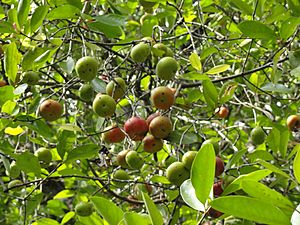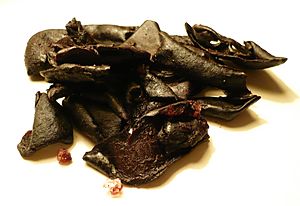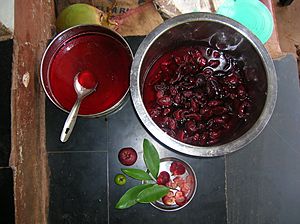Garcinia indica facts for kids
Quick facts for kids Garcinia indica |
|
|---|---|
 |
|
| Kokum fruits, seeds, pulp and rinds | |
| Conservation status | |
| Scientific classification | |
| Genus: |
Garcinia
|
| Species: |
indica
|
Garcinia indica, often called kokum, is a special fruit tree. It belongs to the mangosteen family. People use kokum for cooking, in medicines, and in factories.
Contents
About the Kokum Tree
The Garcinia group of plants has about 200 different types. Most of them grow in warm parts of Asia and Africa. The kokum tree is an evergreen tree, meaning it stays green all year. It can grow very tall, up to 18 meters (about 59 feet), and looks like a pyramid when it's fully grown.
The fruit of the kokum tree is a purple berry, about the size of an orange. Inside, it has five to eight seeds. These seeds make up about a quarter of the fruit's weight. The seeds are squashed and surrounded by a sour, fleshy part.
Where Kokum Grows
Garcinia indica comes from the tropical forests of India. Out of 35 types of Garcinia found in India, 17 are endemic. This means they are found only in India. Seven of these are found only in the Western Ghats region.
The kokum from the Ratnagiri and Sindhudurg areas in Maharashtra, India, has a special "GI tag." This tag shows that it's a unique product from that specific place.
Kokum trees grow in forests, near rivers, and even in empty lands. They love evergreen forests, but can also grow in places with less rain. Farmers also grow kokum on a small scale. It's easy to grow because it doesn't need much water, pesticides, or fertilizers.
How People Use Kokum
Cooking with Kokum
The outer skin of the kokum fruit is dried in the sun. This dried skin is called aamsul or kokam. It's used to make food taste sour, especially in places like Maharashtra, Assam, Karnataka, Goa, and Gujarat. Kokum gives food a unique flavor and a deep red color.
It's often used instead of tamarind in curries and other dishes in South India. In Gujarat, it adds flavor and a tart taste to dal (lentil soup). In Assamese cooking, it's used in many dishes like masor tenga (sour fish curry) and tenga dali (sour dal).
Fresh kokum fruit can be mixed with sugar to make a bright-red drink concentrate. This concentrate is then mixed with water to make a popular drink called Kokum Sarbat.
The juice from the fruit is called aagul in the Konkani and Marathi languages. It's added when making solkadhi, a refreshing drink that can also have coconut milk, coriander, and garlic.
Kokum in Industry
The seeds of the kokum fruit contain something called Kokum butter. This butter stays solid at room temperature. It's used to make chocolates and other sweet treats.
Kokum for Health and Beauty
Kokum butter is also used in skin creams and other products. You might find it in products for skin and hair, including those for acne.
The fruit's rind (outer skin) has a substance called hydroxycitric acid. Some people believe this acid can help change how the body uses fats.
Other Uses of the Tree
The kokum tree is also grown just for its beauty. It has a thick top of green leaves, and its new, young leaves have a pretty red tint.
Gallery
-
Solkadhi made from coconut milk and kokum











